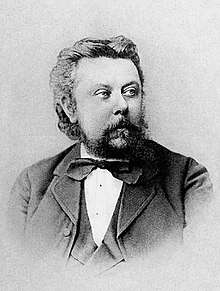Songs and Dances of Death
Songs and Dances of Death (Russian: Песни и пляски смерти, Pesni i plyaski smerti) is a song cycle for voice (usually bass or bass-baritone) and piano by Modest Petrovich Mussorgsky, written in the mid-1870s, to poems by Arseny Golenishchev-Kutuzov, a relative of the composer.

Each song deals with death in a poetic manner although the depictions are realistic in that they reflect experiences not uncommon in 19th century Russia: child death, death in youth, drunken misadventure and war.
The song cycle is considered Mussorgsky's masterpiece in the genre.
Songs
Songs and Dances of Death consists of four individual songs, as follows:
1. Lullaby (Колыбельная) (14 April 1875) (in F-sharp minor–A minor)
- A mother cradles her sick infant, who grows more feverish. Death appears, disguised as a babysitter, and rocks the infant to eternal sleep.
2. Serenade (Серенада) (11 May 1875) (in E minor–E-flat minor)
- The figure of Death waits outside the window of a dying woman, in the manner of a wooing lover.
3. Trepak (Трепак) (17 February 1875) (in D minor)
- A drunken peasant stumbles outside into the snow and becomes caught in a blizzard. The figure of Death invites him to dance a folk-dance called the Trepak. As he freezes to death, he dreams of summer fields and doves.
4. The Field Marshal (Полководец) (5 June 1877) (in E-flat minor–D minor)
- The figure of Death is depicted as an officer marshaling, illuminated by the moon, the dead troops of both armies after a dreadful and bloody battle. She tells them: in life you were enemies but now you are comrades, because you're all dead, and I am your commanding officer. She assures them that although the living will forget about them, she will remember them, and will harden the earth above them so that they cannot be resurrected.
Recordings
The Songs and Dances of Death have been recorded by numerous vocalists, including Vladimir Rosing, George London,[1] Ferruccio Furlanetto,[2] Nicolai Ghiaurov, Boris Christoff,[3] Kim Borg,[4] Martti Talvela (twice: once with piano accompaniment[5] and once with full orchestra[6]), Matti Salminen,[7] Anatoly Kotcherga,[8] Paata Burchuladze, Aage Haugland,[9] Dmitri Hvorostovsky, Ewa Podles, Galina Vishnevskaya, Brigitte Fassbaender, Anja Silja and Yevgeny Nesterenko.[10]
Versions by others
- 1882, Alexander Glazunov and Nikolai Rimsky-Korsakov
- The songs were first orchestrated by Glazunov (Nos. 1 and 3) and Rimsky-Korsakov (Nos. 2 and 4) shortly after Mussorgsky's death. They were published in 1882. Mussorgsky had intended to orchestrate the cycle himself but never realised the ambition. In the Glazunov/Rimsky-Korsakov orchestration, 'Trepak' is first.
- 1962, Dmitri Shostakovich
- Shostakovich orchestrated the whole cycle for the dedicatee, soprano Galina Vishnevskaya. Seven years later, noting that he wanted to continue Mussorgsky's "too short" set of songs, he wrote his Fourteenth Symphony for soprano, bass and chamber orchestra, adding to the musical gallery of death's appearances.[11] The Shostakovich orchestration had a substantial influence on many of his later works, and has since been adapted for bass and baritone voices.
- 1983, Edison Denisov, recorded by Yevgeny Nesterenko in 1985
- 1984, Kalevi Aho
- 1994, Ramon Lazkano (premiered by Dmitri Hvorostovsky)
- 2007, Aleksandr Raskatov
- 2012, Peter Breiner in a version for orchestra only, recorded by him and the New Zealand Symphony Orchestra on Naxos.
References
- George London in Concert, VAI Audio VAIA 1030.
- Rachmaninoff Mussorgsky Songs Ferruccio Furlanetto, Igor Tchetuev. Prestige Classics Vienna.
- Moussorgsky Integrale des Melodies. EMI, CHS 7 63025 2.
- The Art of Kim Borg: Mussorgsky Songs and Dances of Death. Arlecchino.
- Martti Talvela Lied Album, Decca 430 070-2
- Modest Mussorgsky Pictures at an Exhibition, Night on Bare Mountain, Songs and Dances of Death, BIS CD-325 Stereo
- Aho: Symphony Number 3, Mussorgsky: Songs and Dances of Death BIS CD 1186 DIGITAL
- Berliner Philharmoniker Claudio Abbado Sony Catalog number SK 66 276.
- Mussorgsky Complete Songs. CHANDOS DIGITAL, CHAN 9336-8.
- Mussorgsky: Songs and Dances of Death. MELODIYA. MEL 46131-2.
- Volkov, Solomon, St. Petersburg: A Cultural History (New York: The Free Press, a division of Simon & Schuster, Inc., 1995), 106.
External links
- Original libretto as well as Cyrillic option, and English/French translation found here
- Songs and Dances of Death: Scores at the International Music Score Library Project (IMSLP)